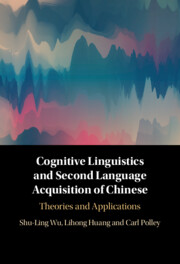Book contents
- Cognitive Linguistics and Second Language Acquisition of Chinese
- Cognitive Linguistics and Second Language Acquisition of Chinese
- Copyright page
- Contents
- Figures
- Tables
- Abbreviations
- Preface
- 1 Cognitive Linguistics and Second Language Acquisition
- 2 Construal in Language
- 3 Concepts and Categorization
- 4 Iconicity and Image Schemas
- 5 Metaphor and Metonymy
- 6 Polysemy
- 7 Embodied Cognition and Mental Simulation
- 8 Teaching Chinese Modal Verbs
- 9 The Future of Cognitive Linguistics in Chinese Studies
- References
- Index
6 - Polysemy
Published online by Cambridge University Press: 01 February 2024
- Cognitive Linguistics and Second Language Acquisition of Chinese
- Cognitive Linguistics and Second Language Acquisition of Chinese
- Copyright page
- Contents
- Figures
- Tables
- Abbreviations
- Preface
- 1 Cognitive Linguistics and Second Language Acquisition
- 2 Construal in Language
- 3 Concepts and Categorization
- 4 Iconicity and Image Schemas
- 5 Metaphor and Metonymy
- 6 Polysemy
- 7 Embodied Cognition and Mental Simulation
- 8 Teaching Chinese Modal Verbs
- 9 The Future of Cognitive Linguistics in Chinese Studies
- References
- Index
Summary
Chapter 6 focuses on polysemy, a common linguistic phenomenon in which a single form is associated with two or more distinct but related senses, as shown in the relatedness of baseball cap and pen cap. Polysemy is a result of meaning extension, which can be triggered by mechanisms such as metaphorical mappings, experiential correlation, or inference. The principled polysemy model proposed by Tyler and Evans (2003) posits that the distinct senses associated with a particular lexical form are related to each other in a systematic and motivated way and are organized around a central or primary sense. Because polysemy is pervasive, the fact that many words have a large number of different senses magnifies the challenge of vocabulary learning. The chapter advocates for L2 instructional approaches that introduce the different senses of a word not in a piecemeal fashion but as a sequence of related meanings starting from the primary sense and continuing to extended senses. Different CL-based pedagogical methods and tasks are presented to showcase how to enable learners to attend to the systematic relationships that exist among the various senses of a lexical form.
Keywords
- Type
- Chapter
- Information
- Cognitive Linguistics and Second Language Acquisition of ChineseTheories and Applications, pp. 121 - 147Publisher: Cambridge University PressPrint publication year: 2024

